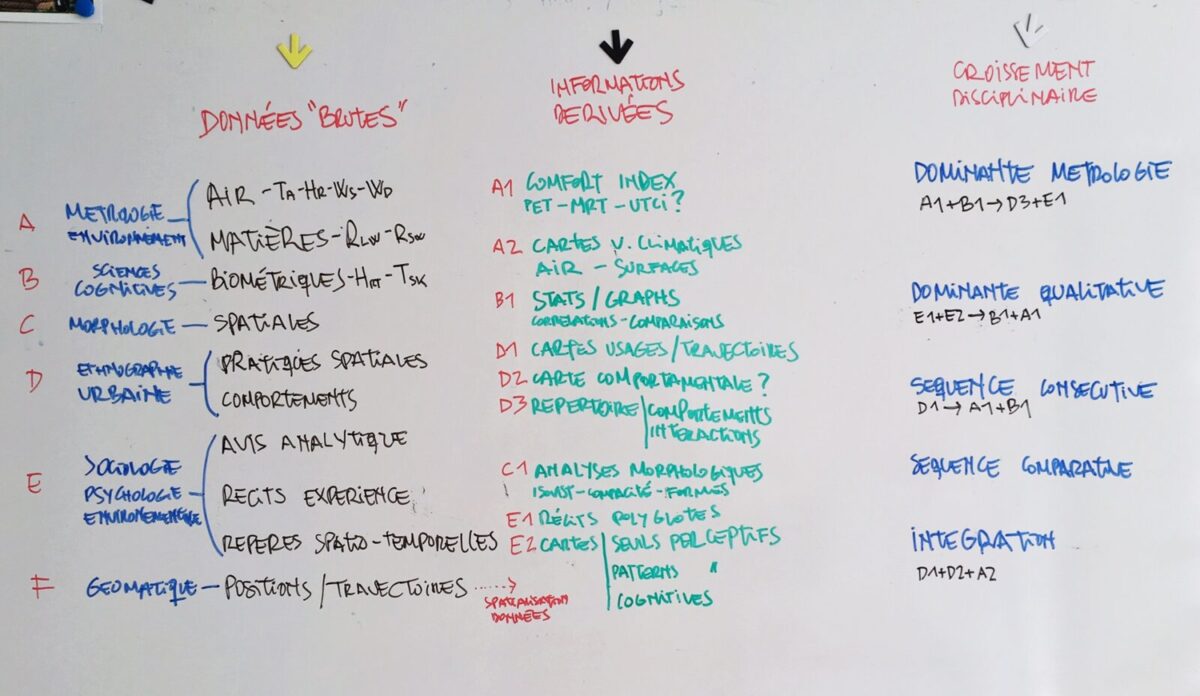Reflections on Interdisciplinary Methods for Studying the effects of Thermo-spatial Perception in the public space
Published on May 25, 2019
Coolscapes is a research project based on an interdisciplinary approach to the thermo-spatial perception of the public space. From our point of view, understanding the manifold phenomena that influence citizens’ thermal perception requires gathering together divers disciplinary research methods. Although research fields such as microclimatology, sensory studies, environmental psychology, cognitive sciences or urban studies deal with the thermal experience outdoors and contribute to knowledge, mixing their methods can lead to new methodological designs in which “the weaknesses inherent in one method, can be compensated by making use of the other method that is assumed not to have the same weaknesses” (Deschepper et al., 2017).
How to go interdisciplinary with thermo-spatial perception without losing the scientific basis of each field? The methodological design of each field guarantees to obtain high quality ‘raw data’ and their analytic procedures. Legitimated by their own scientific paradigm, each discipline has its own concepts and criteria to assess the validity, generalizability and reproducibility of the studies (Creswell, 2007). However, as Jordheim & Grotta (2012) explain, “[r]ather than offering an escape from structures and strictures, interdisciplinarity is about adding more layers and connections – increased complexity, more topics, multiple perspectives, colliding vocabularies”.
Beyond the idealistic complementarity of the aforementioned approaches to thermal perception, an interdisciplinary approach requires a disciplinary tolerance which encourages interactions. In their paper discussing how to link numbers to perceptions and experiences, Deschepper et al. (2017) suggest four strategies helpful for us:
- Dominance of one: methods are basically implemented considering a prevalent disciplinary approach and assuming the other as a complement that serves to aid or to enrich the information.
- Sequential design: methods are connected by a succession, so the latter research works would be guided by the results first ones. This can take several orientations according to the object of the study or the scale of the studied phenomena.
- Concurrent designs: methods are implemented at the same time and are equally important. Inherent to this is the idea that data collected in parallel would be difficult to cross directly, but comparing two concurrent analyses of the same located phenomenon would raise new conclusions.
- Integrated design: two or more methods are implemented in parallel according to an interactive approach in which each method informs the use of the other methods. It involves assuming to grant concessions to disciplinary robustness in order to open new exchange points.
The degree of integration is obviously determinative to consider a study as interdisciplinary. However, according to Deschepper et al., the “full integration of methods is not a condition sine qua non to achieve high-quality studies” and each strategy for interdisciplinarity leads to different results that can be equally valuable.

On-going work: crossing methods for characterizing thermo-spatial perception in the public space.
References
Creswell, J.W. (2007). Qualitative Inquiry and Research Design: Choosing among Five Approaches. London: SAGE.
Deschepper, R., Six, S., Vandeweghe, N., De Couck, M., Gidron, Y., Depoorter, A.-M. et Bilsen, J. (2017). Linking numbers to perceptions and experiences: Why we need transdisciplinary mixed-methods combining neurophysiological and qualitative data. Methodological Innovations, 10(2), 2059799117703119. doi: 10.1177/2059799117703119